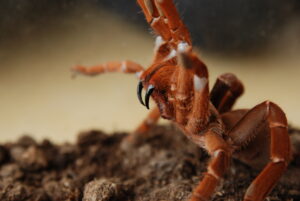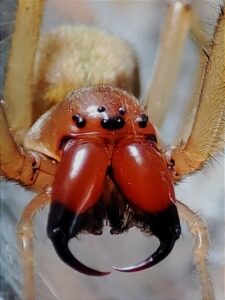The order Araneae are divided into two suborders and the classification are determined by the structure of the chelicerae, and the number of booklungs. The suborder Mygalomorphae, or Orthognatha, got two pairs of booklungs, include 15 families – for example the trapdoor spiders in the family Ctenizidae, and Hexathelidae – funnelweb spiders. The tarantulas belongs to the Theraphosidae family.

The chelicerae are shown with its fangs extended
The mygalomorphs ”jaws”, chelicerae, are located parallel to the body and the spider must raise the front body (see photo above) to be able to insert the fangs into its prey. In the suborder Labidognatha, or araneomorphs includes around 60 families, got one pair of booklungs and the chelicera moves sideways (see photo below). This family are the so called ”true spiders” and include many species.

Cheiracanthium punctorium
Photo: Patryk Kielczewski – Facebook photo page
Among them are those who catch the prey in a web – Araneidae.
Theridiidae, which include the widow spiders, Agelenidae – catches prey on a flat web on the ground and the hunting spiders, Lycosidae, which hunt on the ground and
Salticidae, jumping spiders, active spiders with a excellent eyesight.


The first theraphosid to be described was Avicularia avicularia in 1758 by Carl von Linné in Systema naturae per regna tria naturae.
The family Theraphosidae contains of 158 genera and 1055 species (World Spider Catalog, 2023-03-22). A number of new species are described each year, and sometimes even new genera. We can only speculate how many more that are yet to be discovered.
They are divided into subfamilies:
Acanthopelminae
Ischnocolinae
Selenogyrinae
Spelopelminae
Theraphosinae
Aviculariinae
Eumenophorinae
Stromatopelminae
Harpactirinae
Ornithoctoninae
Selenocosmiinae
Poecilotheriinae
Thrigmopoeinae
These subfamilies include a number of species of which Theraphosinae are the largest with over 40 genera. You find all species on The World Spider Catalog
